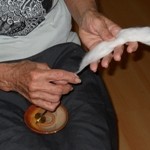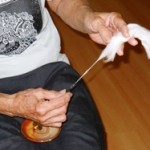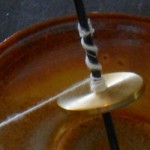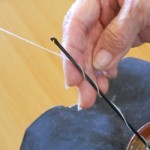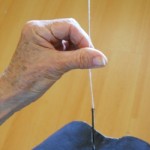Over the years this little spindle has played an important role in the lives of many. This little metal spindle first designed by Gandhi so that everyone in India could be spinning cotton to make yarn to sell to free India from England. Every boy in school got a takli and was taught to spin cotton. Women had them so they could be spinning while traveling as well as at home. Today I use it to meditate and relax as do many others and it serves as an inexpensive tool to spin cotton into yarn in many 3rd world countries.
The portable little spindle loves to travel and is ready to spin at a moment’s notice. Be it at a grandson’s baseball game or while waiting in the dentist office, it is amazing how much gets spun in no time at all. After I have filled my takli with fine cotton thread, I wind it onto a shuttle bobbin with my handy battery bobbin winder. Each time I attach the ends together before winding more yarn onto the bobbin. It is surprising how soon you have two full bobbins that you can take to your spinning wheel and ply into a lovely warp or knitting yarn.
Singles can be woven directly from the shuttle bobbins after they have set a day or two on the bobbin. Knitters should always skein off their plied yarn and wash it in hot soapy water, rinse and hang to dry before using. Weaver will calculate shrinkage while knitters are used to scoured finished yarns to knit with.
Spinning on a takli spindle.
Before you actually start spinning on your spindle, you should practice spinning without the fiber. Set the spindle in a bowl or shell and hold the shaft near the top between your right thumb and first finger. Draw your finger back across the thumb making the spindle spin clockwise. As your finger comes back off your thumb, bring the middle finger up to the thumb forming a cradle for the spindle to spin in. Practice this action until you can do it naturally and with ease. The spindle should spin for about 10 seconds without stopping. Now you are ready to spin some nice fine thread.
MAKING A LEAD:
1.Hold the cotton fiber in your left hand and the spindle in your right hand.* Catch a few fibers on the spindle hook, pinch them and draw them just slightly out of the fiber mass. Rotate the spindle several turns clockwise. This will start your lead.
2. Hold the spindle upright, pinch the fibers on the hook and draw your fiber mass up a little. Spin the spindle and let the twist run up the lead.
3. Repeat this until you have about two feet of thread. Draft out any slubs and give the spindle a spin to put more twist in your thread. Now slide the end of the thread down the shaft, and wind half of it clockwise around the base of the shaft, just above the whorl. You have made yourself a lead for your spindle.
READY TO SPIN:
4. Lay the last foot of thread (lead) up the shaft, lean the spindle slightly to the left. Hold the fiber gently, and the spindle firmly and draft out fibers until it feels real weak,. Now give your spindle a spin, letting the lead wrap around the shaft and putting strength in the drafted fibers.
5. Pinch at the top of the spindle with your right thumb and first finger, holding the thread firmly, draw out more fibers until the thread becomes weak. Then spin again. Do this until you have almost an arm’s length of thread. Then draft out the slubs by pinching off the twist with your left thumb and first finger so the extra twist will not go up into the loose fiber. Now gently pull on the thread until the slubs come out. Give it a quick spin. Lastly holding the thread taunt, (lift the spindle out of the bowl and the weight of the spindle will keep the thread taunt), give the spindle a good spin and strengthen the thread. Wind onto the spindle leaving about 12 inches to spiral up the shaft to start again.
Pinch, draft and spin…pinch, draft and spin
*Left-handed spinners must draw back their thumb to get a clockwise spin if holding the spindle in their left hand.
Go to my web site, www.cottonspinning.com and check out the You Tubes that I have produced, especially the one on spinning with the takli. Be patient and remember practice is the source for perfection.
Click HERE for the next article
